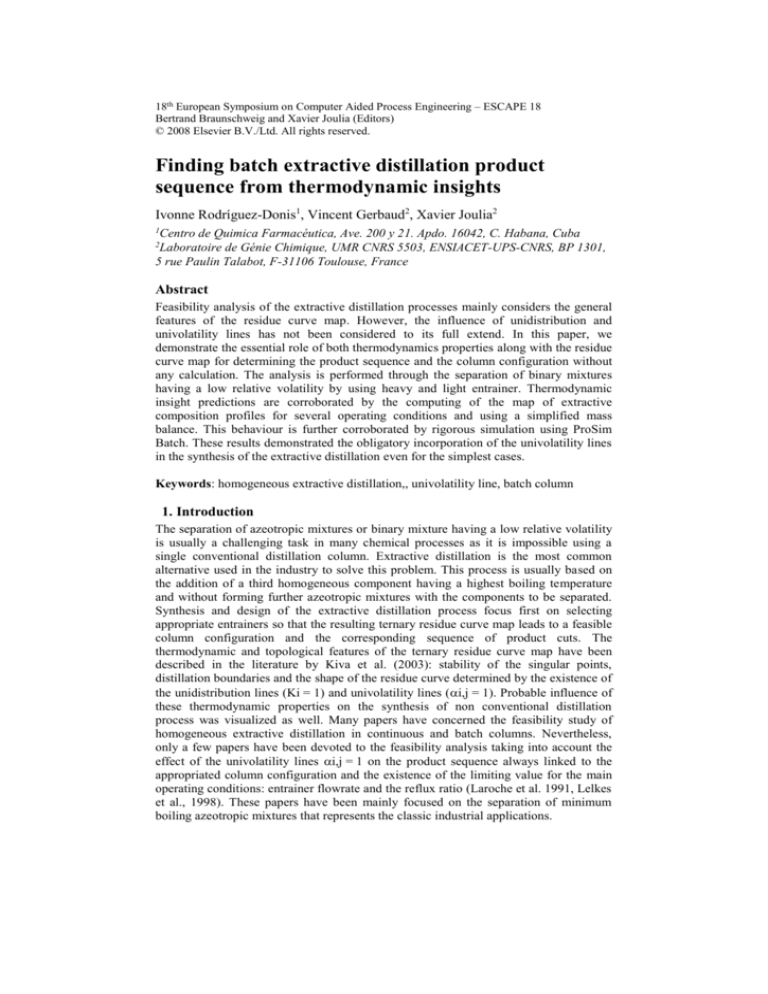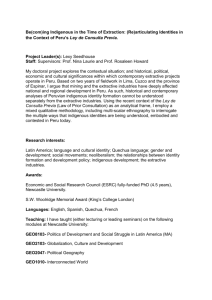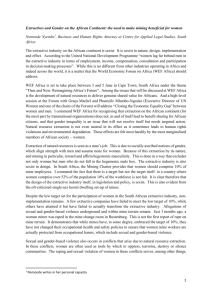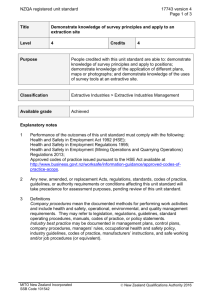
18th European Symposium on Computer Aided Process Engineering – ESCAPE 18
Bertrand Braunschweig and Xavier Joulia (Editors)
© 2008 Elsevier B.V./Ltd. All rights reserved.
Finding batch extractive distillation product
sequence from thermodynamic insights
Ivonne Rodríguez-Donis1, Vincent Gerbaud2, Xavier Joulia2
1
Centro de Quimica Farmacéutica, Ave. 200 y 21. Apdo. 16042, C. Habana, Cuba
Laboratoire de Génie Chimique, UMR CNRS 5503, ENSIACET-UPS-CNRS, BP 1301,
5 rue Paulin Talabot, F-31106 Toulouse, France
2
Abstract
Feasibility analysis of the extractive distillation processes mainly considers the general
features of the residue curve map. However, the influence of unidistribution and
univolatility lines has not been considered to its full extend. In this paper, we
demonstrate the essential role of both thermodynamics properties along with the residue
curve map for determining the product sequence and the column configuration without
any calculation. The analysis is performed through the separation of binary mixtures
having a low relative volatility by using heavy and light entrainer. Thermodynamic
insight predictions are corroborated by the computing of the map of extractive
composition profiles for several operating conditions and using a simplified mass
balance. This behaviour is further corroborated by rigorous simulation using ProSim
Batch. These results demonstrated the obligatory incorporation of the univolatility lines
in the synthesis of the extractive distillation even for the simplest cases.
Keywords: homogeneous extractive distillation,, univolatility line, batch column
1. Introduction
The separation of azeotropic mixtures or binary mixture having a low relative volatility
is usually a challenging task in many chemical processes as it is impossible using a
single conventional distillation column. Extractive distillation is the most common
alternative used in the industry to solve this problem. This process is usually based on
the addition of a third homogeneous component having a highest boiling temperature
and without forming further azeotropic mixtures with the components to be separated.
Synthesis and design of the extractive distillation process focus first on selecting
appropriate entrainers so that the resulting ternary residue curve map leads to a feasible
column configuration and the corresponding sequence of product cuts. The
thermodynamic and topological features of the ternary residue curve map have been
described in the literature by Kiva et al. (2003): stability of the singular points,
distillation boundaries and the shape of the residue curve determined by the existence of
the unidistribution lines (Ki = 1) and univolatility lines (i,j = 1). Probable influence of
these thermodynamic properties on the synthesis of non conventional distillation
process was visualized as well. Many papers have concerned the feasibility study of
homogeneous extractive distillation in continuous and batch columns. Nevertheless,
only a few papers have been devoted to the feasibility analysis taking into account the
effect of the univolatility lines i,j = 1 on the product sequence always linked to the
appropriated column configuration and the existence of the limiting value for the main
operating conditions: entrainer flowrate and the reflux ratio (Laroche et al. 1991, Lelkes
et al., 1998). These papers have been mainly focused on the separation of minimum
boiling azeotropic mixtures that represents the classic industrial applications.
2
I. Rodriguez-Donis et al.
In this paper, we demonstrate the essential role of the unidistribution and univolatility
lines in the feasibility of the extractive distillation through the analysis of the simplest,
rarely looked case: separation of low relative volatility () binary mixture using light
and heavy homogeneous entrainers. First, the thermodynamic and topological properties
of the ternary diagram 0.0-1 are presented including the existence of Ki = 1 and i,j = 1
lines. The accomplishment of a general criterion for both original components is
verified combining the effect of the univolatility lines and the residue curve map in the
resulting ternary diagram. Later, the map of extractive liquid profiles is computed by
using the simplified model proposed by Lelkes et al. (1998) and these results were
corroborated by rigorous simulation using ProSim Batch software (ProSim S.A).
2. Thermodynamic and topological features of the ternary diagram 0.0-1
The sole ternary diagram 0.0-1 denotes the separation of low binary mixture with any
type of entrainer. The position of the component is determined by the boiling
temperature of the entrainer. Figure 1 displays the thermodynamic and topological
properties of the ternary diagram involving a heavy (a) and a light (b) entrainer. In any
case, the ternary diagram contains only one unidistribution line corresponding to the
saddle point and it can involve until two univolatility lines between the saddle
component and each node component. Hence, the univolatilities lines AB can be
exhibited by the ternary system changing the volatility order between the components.
Inspection of the residue curve map in Figure 1a (resp.1b) would suggest that
component A (resp.B) is the sole unstable (resp. stable) node and it will be always
drawn as the first distillate cut (resp. bottom product) in a rectifying (resp. stripping)
column. But, this statement is incomplete as the presence of the univolatility line AB
produces the apparition of a the new region wherein the component B (resp. A) is the
most volatile (resp. heaviest) component. Therefore, we state that both components A
and B accomplish the general feasibility criterion for the extractive distillation process
at the same time (see Figure 1): existence of the residue curve connecting E to A or B
following a decreasing (a) or increasing (b) temperature direction inside the region
where A and B are the most volatile (a) or the heaviest (b) component of the mixture.
B(s)
A(s)
A>B>E: A more volatile than B more volatile than E
KB=1
KA=1
A,B=1
A>B>E
B>A>E
E(sn)
B,E=1
E>A>B
A>E>B
A>E>B
(a)
A,E=1
A(un)
B (sn)
A,B=1
E>B>A
(b)
E(un)
Figure 1. Topological and thermodynamic properties of the ternary diagram 0.0-1.
3. Separation of low binary mixtures using heavy entrainers by
extractive distillation process.
In general, separation of a low binary mixture has been poorly treated in the
specialized literature because it is considered as a very simple separation case. Two
ternary systems have been reported in the specialized literature by using a batch
rectifier: heptane – toluene – phenol (Lang et al., 1994) and heptane – toluene –
Finding batch extractive distillation sequence from thermodynamics insights
chlorobenzene (Varga, 2006). In both cases the univolatility lineAB doesn’t exists and
the light original component was always drawn as the first distillate product.
However, in the case of the separation of the mixture ethyl acetate (A) – benzene (B)
using n-hexanol (E) as heavy entrainer, the univolatility line AB exists and divides the
composition space in two regions having a similar size. Figure 2 shows the residue
curve map along with the undistribution line KB=1 and the univolatility line AB.
UNIFAC was used as thermodynamic model. In the right region of AB=1, the unstable
A is the most volatile component
benzene (B)
whereas in the opposite region it is the
saddle B. As denoted in Figure 2, in the
xPB
case that ethyl acetate is the product
KB=1
sought, there is a maximum value for
the entrainer flowrate (FmaxA) and the
A,B=1
interception between the extractive and
SNB
the rectifying profile occurs at the
B>A>E
extractive stable node SNA between the
vertex A and xPA. The position of xPA
A>B>E
determines the value of FmaxA. The
opposite behavior is observed for
xPA
benzene (B) as the product where a
n hexanol (E)
ethyl acetate (A)
minimum value for the entrainer
SNA
Figure 2. Residue curve map of the mixture ethyl
flowrate exists (FminB) and the
acetate + benzene + n hexanol
interception between the extractive and
the rectifying profile takes place at SNB between xPB and the vertex of n-hexanol.
3.1. Limiting entrainer feed flowrate
In fact, for F<FmaxA, the ethyl acetate goes to the column top while if F>FminB, benzene
will replace the ethyl acetate at the top. A more interesting scenario take places when
FmaxA<F<FminB as we can see in Figure 3. The map of extractive profiles was computed
for F/V=0.5 at total reflux ratio based on the short-cut model proposed by Lelkes et al.
(1998). In this case, both stable and unstable extractive separatrices exist even at total
reflux operation dividing the ternary system in four regions. The map of the extractive
profiles exhibits four singular extractive points: two stable nodes SNA and SNB connected
by the stable extractive separatrix and the unstable extractive separatrix linking the
unstable extractive node as hexanol vertex to the binary side AB at UNAB. The ternary
extractive saddle point SEXT is located on the univolatility line AB at the crossing point
of both extractive separatrices. Depending on the initial still composition (above or
below the unstable extractive separatrix), A or B goes up to the column top because the
an extractive profile going to SNA or SNB connects xstill to the residue curve.
3.2. Validation by simulation
The peculiar behaviour is verified by rigorous simulation using ProSim Batch program
(ProSim S.A) and considering the following column features: total number of
equilibrium stages (NT=90), n-hexanol is fed at the tray 10, total condenser, adiabatic
column, negligible liquid holdup and not pressure drop. The initial charge into the still
has two composition values, xS1 and xS2, located below and above of the unstable
extractive separatrix. The entrainer flowrate and the heat duty in the boiler were defined
to give an approximate value for F/V of 0.5 inside the extractive section. Figure 3 shows
the simulation results for both cases, particularly, the still composition trajectory and the
liquid profile inside the column after the operation at total reflux with continuous
feeding of n-hexanol during 0.5h. As we can see in Figure 3, simulation results agree
3
4
I. Rodriguez-Donis et al.
very well with the liquid profiles computed by the simplified model. For the initial still
composition xS1, at the end of the operating step using F/V=0.5 and infinite reflux, the
elevated number of trays in the extractive section (80) is not enough to reach the
selected residue curve passing through xDA indicated in Figure 2. In this case, the
extractive profile intercepts a preceding residue curve and giving a lower purity of the
ethyl acetate (xDA) at the column top. However for the still composition xS2, the
extractive profile ends at the binary side BE intercepting a residue curve passing very
close to the BE edge and benzene stays at the column top with a high purity (xDB). It
should be noted for the initial still composition x S2, that ethyl acetate (unstable node) is
first settled at the condenser when the column is started up at total reflux without
entrainer feeding. As expected, the steady state liquid profile lies on the binary side AB
linking xS2 to ethyl acetate vertex. But when n-hexanol is fed at total reflux,, ethyl
acetate is substituted by benzene .
Benzene (B)
1
F/V=0.5
R
0
0.9
0.1
0.8
xDB
stable extractive separatrix
unstable extractive separatrix
0.2
0.7
SNB
still path
xS2
0.3
0.6
rectifying liquid profile
0.4
0.5
extractive liquid profile
0.5
0.6
UN
AB
0.4
SEXT
0.3
0.7
0.2
xS1
A or B
0.8
0.1
0.9
0
xAB
E
1
1
0.9
0.8
n hexanol (E)
0.7
0.6
0.5
0.4
0.3
SNA
0.2
0.1
0
ethyl acetate (A)
A+B
Figure 3. Map of extractive profiles and simulation results. Ethyl acetate + benzene + n hexanol
In the previous example, the withdrawal of ethyl acetate is difficult but achievable
depending on the value of F/V. However, the difficulty increases when the univolatility
line AB moves towards the binary side AB decreasing the region wherein component A
is the lightest component. That is the case of the separation of the same binary mixture
ethyl acetate – benzene but with 1-butanol used as heavy entrainer.
The residue curve map is shown in Figure 4 using UNIQUAC as thermodynamic
model. Benzene is the most volatile component in the region located below of the
AB=1 and this region covers almost the whole composition space. This thermodynamic
scenario benefits mainly the separation of benzene even if the ethyl acetate is the
unstable node of the ternary system. Figure 4 also displays the extractive profile map at
total reflux for identical F/V=0.5 of Figure 3. As we can see only the stable extractive
separatrix exists linking the stable extractive node SNB to the extractive saddle SAE.
Besides, SNB is placed on the binary side BE crossing the specified residue curve that
reaches the selected purity for benzene xDB. In this case, the whole ternary diagram
matches with the feasible region for separating B because any internal still composition
can be connected to xDB by a combination of extractive and rectifying profiles.
Finding batch extractive distillation sequence from thermodynamics insights
benzene (B)
1
0
0.9
F/V=0.5
R
xDB
0.8
0.7
stable extractive separatrix
0.1
rectifying liquid profile
0.2
A>B>E
0.3
0.6
SBN
extractive liquid profile
0.4
0.5
0.5
B>A>E
0.4
0.6
0.3
0.7
0.2
E
0.8
0.1
0.9
0
1
1
B
0.9
0.8
n butanol (E)
0.7
0.6
0.5
0.4
SAE
0.3
0.2
0.1
0
A+B
ethyl acetate (A)
Figure 4. Map of extractive profiles for the mixture ethyl acetate + benzene + n butanol
4. Separation of low binary mixtures using light homogeneous
entrainers by extractive distillation process.
In the case of the separation of low binary mixture AB with a light entrainer E, the
component A is a saddle while the component B and E are the stable and unstable node,
respectively (Figure 1b). Simple inspection of the residue curve map in Figure 1b,
suggests that component B will be always drawn as the first bottom product in a
stripping column because B is the sole stable node of the ternary system and no
boundary exist in the residue curve map. Again, we state that this statement is not valid
when the univolatility line AB exists because it provides a new region where the saddle
component A is the heaviest component. Therefore, both components A and B are able
to go down to the column bottom under total reflux ratio by feeding the light entrainer
at the intermediate position of the stripping column.
This behavior is studied through the analysis of the separation of ethyl acetate – benzene
using acetone as light entrainer. Figure 5 displays the residue curve map and the
univolatility line AB computed using NRTL as thermodynamical model. It divides the
composition space in two regions and similarly to the previous example, the saddle
component A is the heaviest component in the right region whereas in the opposite
region is the stable node B. Besides, in each region there is a residue curve going from
the vertex E to A or B following an increasing temperature direction. Hence, both
original components accomplish the our general feasibility criterion at the same time.
The respective distillate purities for both original components are indicated in Figure 4
as xDA and xDB because the residue curve is considered as the stripping liquid profile at
total reflux. Figure 5 also displays the map of extractive liquid profiles for F/V=0.3 at
total reflux. Similar to Figure 3, there are two extractive separatrices linking the stable
extractive nodes SNA and SNB and the unstable extractive nodes corresponding to the
acetone vertex and UNAB located at AB edge. The unstable extractive separatrix
confines the separation of ethyl acetate and benzene as bottom product and it depends
on the location of the initial composition inside the top vessel.
Also note that there is a maximum value of the entrainer flowrate for separating ethyl
acetate (FmaxA) because SNA is located between the vertex A and xPA when F<FmaxA. As
5
6
I. Rodriguez-Donis et al.
expected, there is a minimum value for benzene (FminB) and the interception between the
extractive and the stripping profile occurs at SNB between xPB and the acetone vertex for
F>FminB. Logically, the map of extractive liquid profiles shown in Figure 5 corresponds
to the condition involving FmaxA<F<FminB. In conclusion, separation of component A or
B will depend on the selected value of F/V and on the location of the initial composition
of the binary original mixture into the ternary diagram. Similarly to the separation of
ethyl acetate – benzene mixture with heavy entrainers, the recovery of the saddle
original component will be facilitated by the use of the light entrainer moving the
univolatility line towards the binary side AB.
ethyl acetate (A)
xDA
F/V=0.3
R
stable extractive separatrix
unstable extractive separatrix
AB=1
stripping liquid profile
SNA
extractive liquid profile
UNAB
E>A>B
E>B>A
SEXT
A+B
E
xDB
benzene (B)
A or B
SNB
acetone (E)
Figure 5. Map of extractive profiles for the mixture acetone + ethyl acetate +benzene
5. Conclusions
Synthesis and design of the separation of low relative volatility by extractive distillation
is not a simple dilemma. Combined analysis of the residue curve map and the
univolatility lines is required for determining the original component to be drawn as the
first product cut. Also, the univolatility line AB determines the existence of the limiting
values for the entrainer flowrate and the feasibility of the separation of the original
components A or B depends strongly on the location of the initial composition into the
ternary composition space. These preliminary results promotes the obligatory
integration of the univolatility lines as additional thermodynamic tool in the preliminary
feasibility studies of the separation of non ideal binary mixtures by homogeneous
extractive distillation process, mainly in the case involving azeotropic mixtures and not
covered by this study.
References
L. Laroche, N. Bekiaris, H.W. Andersen, M. Morari, 1991, The Can. J. of Chem. Eng., 69, 1302.
P. Lang P., H. Yatim, P. Moszkowicz and M. Otterbein, Comput. 1994, Chem. Eng., 18, 1057.
ProSim SA, 2001, www.prosim.fr
V. Varga, PhD. Dissertation., available at http://erasme.inp-toulouse.fr INP-Toulouse, 2006
V.N. Kiva, E.K. Hilmen, S. Skogestad, 2003, Chem. Eng. Sci., 58, 1903.
Z. Lelkes, P. Lang, B. Benadda, and P. Moszkowicz, 1998b, AIChE Journal, 44, 810.







